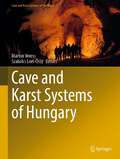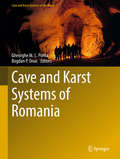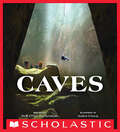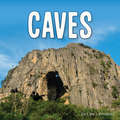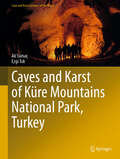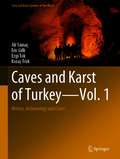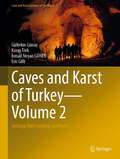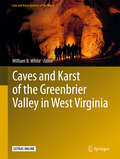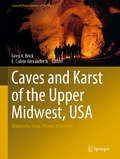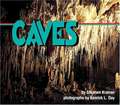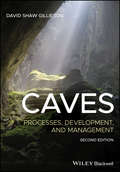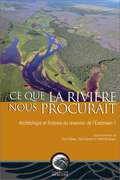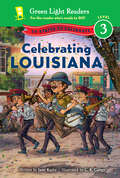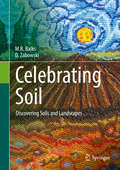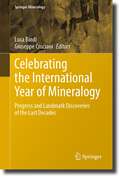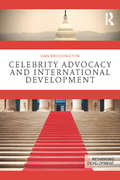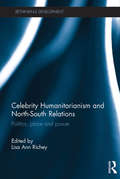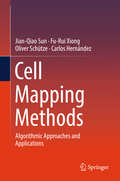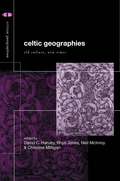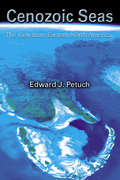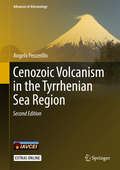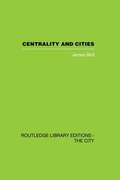- Table View
- List View
Cave and Karst Systems of Hungary (Cave and Karst Systems of the World)
by Márton Veress Szabolcs Leél-ŐssyThis book describes Hungarian karst areas and Hungarian karst research results. The chapters present the general characteristics of karst areas, their geology, their paleokarst, their hydrology, their surface and subsurface morphology (more significant caves are classified according to karst areas and their morphology and development is described), ecology and flora and fauna.This book also includes a separate chapter which deals with the history of Hungarian karst and cave research. Another chapter deals with theories that were made during Hungarian karst researches.
Cave and Karst Systems of Romania (Cave and Karst Systems of the World)
by Gheorghe M. Ponta Bogdan P. OnacThis book focuses on Romania’s more than 12,000 caves, which developed in limestone (including thermal water caves), salt, gypsum, and occasionally in sandstone. It examines these caves and related topics in a format suitable for cavers, while also addressing a broad range of aspects useful for students and researchers. Since the Institute of Speleology was first established by Emil Racovita in 1920, a great deal of research has been conducted on all cave and karst types. As such, the book examines a variety of scientific fields, including karst geology, hydrogeology, biospeleology, paleoclimatology, mineralogy and archaeology.
Caves
by Nell Cross BeckermanA masterful exploration of one of nature's most curious ecosystems, Caves is a magical journey into subterranean wonders perfect for fans of Jason Chin.In the shade of the woods is a hill with a hole. Beaconing black. Goosebump chills. Excitement and fear battle. What will win? You want to go in...do you dare?Using evocative storytelling, Nell Cross Beckerman urges children to explore one of nature's most curious ecosystems. Dramatic, poetic language guides kids through different caves around the world while nonfiction text allows for deeper understanding.Debut illustrator Kalen Chock's stunning illustrations will astonish readers, as each new page brings another delightful surprise.Extensive backmatter includes an author's note, best practices for safe cave exploration, and additional information about the caves featured in the book.An ideal choice for nature lovers, future explorers, and fans of Jason Chin and Kate Messner.
Caves (Earth's Landforms)
by Lisa J. AmstutzAll caves are underground, but there is more to these landforms than meets the eye! Water forms some caves, while volcanic lava forms others. Some have waterfalls, while others have huge stalactites and stalagmites. Give beginning readers all the need-to-know information about canyons, including their characteristics, how they form, and where they can be found around the world.
Caves and Karst of Küre Mountains National Park, Turkey (Cave and Karst Systems of the World)
by Ali Yamaç Ezgi TokThis book is a first in its own way. As a result of more than two years of cooperation with the General Directorate of National Parks, a cave inventory of a national park has been prepared for the first time in Turkey. The amazing canyons, caves, sinkholes, and waterfalls give the Küre Mountains National Park the reputation it deserves today and the unique vegetation and wildlife that complement them. This national park, located in northwestern Turkey, covers an area of 370 sq km. In addition, an area of about 800 sq km around this national park has been recognized as a buffer zone. With 125 caves discovered and surveyed so far, Küre Mountains National Park is one of the national parks with the greatest number of caves and has a worldwide significance simply because of this feature. This book provides a complete inventory of these caves.
Caves and Karst of Turkey - Vol. 1: History, Archaeology and Caves (Cave and Karst Systems of the World)
by Eric Gilli Ali Yamaç Ezgi Tok Koray TörkThis book comprehensively reviews the historical background of speleology and cave research in the contexts of archeology and natural sciences. It also offers a summary of selected topics related to the karstic terrain of Turkey. Covering 40 % of the country's surface area, Turkey's karstic terrain accommodates thousands of caves. However, understanding the geology, geomorphology, hydrology, biology, and ecosystem dynamics of these caves is still limited. Despite numerous explorations and extensive fieldwork, this is the first comprehensive publication on the topic since 1984. The book presents the 45 most significant caves in Turkey, selected according to several criteria, including esthetical uniqueness. It covers caves of global archeological importance, such as Karain, Yarımburgaz and Üçagızlı, and some of the world's deepest caves, such as Peynirlikönü, Kuzgun, Morca, and Çukurpınar. The book includes a survey and a detailed description of the genesis, geology, geomorphology, and exploration history for each cave.
Caves and Karst of Turkey - Volume 2: Geology, Hydrogeology and Karst (Cave and Karst Systems of the World)
by Eric Gilli Koray Törk Gültekin Günay İsmail Noyan GÜNERThis book discusses Turkey's karst systems' most critical features, one of the world's most important karst areas. This publication has been prepared to assist geologists and professionals working in karst areas by solving several different problems, for example, to conduct groundwater analysis in regions with karstic depressions and examine subsidence problems through geotechnical and hydrogeological studies to solve dams' technical challenges from Karstic areas.
Caves and Karst of the Greenbrier Valley in West Virginia (Cave and Karst Systems of the World)
by William B. WhiteThe focus of this book is on the more than 2000 caves of the Greenbrier Valley of West Virginia of which the 14 with lengths greater than 10 km have an aggregate length of 639 km. The major caves form the core part of sub-basins which drain to big springs and ultimately to the Greenbrier River. Individual chapters of this book describe each of the major caves and its associated drainage basin. The caves are formed in the Mississippian Greenbrier Limestone in a setting of undulating gentle folds. Fractures, lineaments and confining layers within the limestone are the main controlling factors. The caves underlie an extensive sinkhole plain which may relate to a major erosion surface. The caves are habitat for both aquatic and terrestrial organisms which are cataloged and described as are the paleontological remains found in some of the caves. The sinkhole plain of the Greenbrier karst and the underlying complex of cave systems are the end result of at least a ten million year history of landscape evolution which can be traced through the evolving sequence of cave passages and which is described in this book.
Caves and Karst of the Upper Midwest, USA: Minnesota, Iowa, Illinois, Wisconsin (Cave and Karst Systems of the World)
by Greg A. Brick E. Calvin Alexander Jr.This book discusses the karst and pseudokarst of the Upper Midwest, USA, consisting of the states of Minnesota, Wisconsin, Iowa, and Illinois—the first regional synthesis in 40 years. Starting with an overview of the regional geology of what is largely glaciated fluviokarst and paleokarst developed on Paleozoic carbonates, but including other lithologies such as the St. Peter Sandstone and the Ft. Dodge Gypsum, the caves, springs, sinkholes, and karst hydrogeology of each state are described. Special attention is devoted to the region’s longest caves: Coldwater Cave, Mystery Cave, and the Minnesota Cave Preserve caves. Application of tools such as data loggers and LiDAR, with new conceptual models such as hypogenic speleogenesis, has been transformative here. Special topics include lead and zinc mining in the Driftless Area, vertebrate and invertebrate cave fauna near the Laurentide ice limit, the impact and policies of nutrient and herbicide intensive modern agriculture on karst, and paleoclimate studies. The discovery, exploration, institutional history of caving organizations, and show caves of the Upper Midwest, from the year 1700 onwards, are brought up to date. The top 10 historical paradigms of cave and karst science in the Midwest are reviewed. Perspectives on paleontology, archeology, and Native American rock art are included.
Caves: Nature in Action
by Stephen KramerLearn more about how caves are made and what goes on within them.
Caves: Processes, Development, and Management
by David Shaw GilliesonPeople have been interested in caves for a very long time. Our distant ancestors used them for shelter, as sources of water, and as places in which to conduct essential rituals. They adorned their walls with quite sophisticated artwork depicting both their existential and spiritual concerns. Caves feature in our mythology, they are used as places of worship in many cultures, and they are used throughout the world as places in which to store prized foodstuffs and wine. For at least two hundred years they have attracted scientists, artists, photographers, and recreational cavers. This book aims examines how caves form, the light they shed on past environments and climates, and the values, both environmental and cultural, that they provide to humanity. This second edition of Caves: Processes, Development, and Management is a welcome revision of the author’s earlier treatment released over twenty years ago. It has been updated, significantly expanded, and largely rewritten. The intervening years have seen a dramatic increase in karst and cave research globally, with significant advances in our understanding of fundamental processes, in our ability to extract proxy climatic and environmental data from cave deposits, and in our understanding of the breadth of cave values and as a result the complexity of their management needs. This new edition adopts a broad international perspective in the research examples used and the cited literature, and has actively sought out material from the tropical world and the southern continents, thus avoiding the European and North American bias frequently found in speleological publications. Caves: Processes, Development, and Management, Second Edition, is organised into four sections. In the first section, contemporary processes of cave formation are examined. The second section of the book deals with past processes and their physical manifestation. In the third section, the use of caves by various organisms from bacteria to humans is explored. The final section of the book reviews our changing approaches to cave management and to catchment management on karst terrains. The book will be of use to anyone who is interested in caves and karst, or who wants to understand about cave formation, development, values and management.
Caving: Exploring Limestone Caves
by Larry Dane BrimnerThe book offers information on limestone caves. Students will learn about the rules, the gear, the professionals involved, and more in this book.
Ce que la rivière nous procurait: Archéologie et histoire du réservoir de l’Eastmain-1 (Mercure)
by Pierre Bibeau, David Denton et André BurroughsLa réalisation de l’aménagement hydroélectrique de l’Eastmain-1 a créé en 2006 un réservoir de 603 kilomètres carrés sur le territoire d’Eeyou Istchee Baie-James. Des recherches archéologiques préventives y ont été menées entre 2002 et 2005 dans le cadre des études environnementales de la Société d’énergie de la Baie James et du Programme sur l’archéologie et le patrimoine culturel prévues par une convention avec le peuple cri. Grâce à une collaboration remarquable entre les équipes d’archéologues, de géographes et d’ethnologues d’Arkéos inc., le consultant retenu, et de l’Administration régionale crie, un travail colossal a été entrepris et les recherches aux abords de la rivière Eastmain ont conduit à la mise au jour de 158 sites couvrant cinq millénaires d’occupation humaine. Les 18 contributions abordent autant d’angles de discussion relatifs au milieu naturel, à l’histoire culturelle et aux vestiges mis au jour, mais c’est l’amour de ces terres et de la rivière qui s’exprime dans chaque page de cet ouvrage. Publié en français
Celebrating Louisiana (Green Light Readers Level 3)
by Jane KurtzLet the good times roll as you discover the great state of Louisiana in this fun, information-packed guide.Say hello to Mr. Geo, everybody's favorite geography teacher! He loves to explore new places. Today he's visiting Louisiana, the Pelican State. His first stop is New Orleans for the Mardi Gras parade. He's going to sample Cajun cooking, listen to jazz, ride riverboats and tour eerie swamps and beautiful mansions, too. Join Mr. Geo on his travels around Louisiana. Together, you will discover what makes this a state to celebrate. Includes maps and learning activities. Colorful, you-are-there illustrations and easy-to-read text are great for beginning and newly independent readers!
Celebrating Soil: Discovering Soils and Landscapes
by M. R. Balks D. ZabowskiThis richly illustrated book celebrates the diversity, importance, and intrinsic beauty of soils around the world and helps the reader to understand the ways that soils are related to the landscapes in which they form. The book unravels the complex bond between humans and soils and the importance of soils in our cultures and everyday lives. Soil is critical to terrestrial life on earth. It underpins human food supply and provides materials on which we build our lives. Soil is out of sight and often out of mind, thus easy to overlook. Yet soil has tremendous variety and intrinsic beauty for those who care to look. Soil contains a memory of the events that have shaped the landscape and the environment. With help you can look at a soil and understand the stories that it has to tell. Written in a reader-friendly way, Celebrating Soil is a wonderful resource for farmers, horticulturalists, naturalists, students and others who are concerned about how soils are formed, work and are used.
Celebrating the International Year of Mineralogy: Progress and Landmark Discoveries of the Last Decades (Springer Mineralogy)
by Luca Bindi Giuseppe CrucianiThis volume celebrates mineral sciences and what are considered the most important progresses and breakthroughs in this discipline. Authoritative authors, who, in most cases, are the direct discoverers recount the steps of their research, which represent landmark developments of mineralogy and mineralogical crystallography.
Celebrity Advocacy and International Development (Rethinking Development)
by Dan BrockingtonCelebrity advocacy is a curious phenomenon. It occupies a significant proportion of the public domain, but does so without engaging particularly well with much of the public. Yet this may not matter very much. Many people at the core of advocacy, and in political and business elites, simply do not notice any lack of engagement. In these circles celebrity advocacy can be remarkably effective. Celebrity Advocacy and International Development examines the work of celebrity advocacy and lobbying in international development. Its purpose is to understand the alliances resulting, their history, consequences, wider contexts and implications. It argues that celebrity advocacy signals a new aspect of elite rule. For populist celebrity advocacy can mark, ironically, a disengagement between the public and politics, and particularly the public and civil society. Recognising this poses new challenges, but also presents new opportunities, for the development movement. This book gives students and researchers in development studies and media studies a wealth of original empirical data, including interviews across the NGO sector, media and celebrity industries, newspaper analysis, large surveys of public opinion, and focus group research.
Celebrity Humanitarianism and North-South Relations: Politics, place and power (Rethinking Development)
by Lisa Ann RicheyDiscussion over celebrity engagement is often limited to theoretical critique or normative name-calling, without much grounded research into what it is that celebrities are doing, the same or differently throughout the world. Crucially, little attention has been paid to the Global South, either as a place where celebrities intervene into existing politics and social processes, or as the generator of Southern celebrities engaged in ‘do-gooding’. This book examines what the diverse roster of celebrity humanitarians are actually doing in and across North and South contexts. Celebrity humanitarianism is an effective lens for viewing the multiple and diverse relationships that constitute the links between North and South. New empirical findings on celebrity humanitarianism on the ground in Thailand, Malawi, Bangladesh, South Africa, China, Haiti, Congo, US, Denmark and Australia illustrate the impact of celebrity humanitarianism in the Global South and celebritization, participation and democratization in the donor North. By investigating one of the most mediatized and distant representations of humanitarianism (the celebrity intervention) from a perspective of contextualization, the book underscores the importance of context in international development. <P><P>This book will be of interest to students and researchers in the fields of development studies, celebrity studies, anthropology, political science, geography, and related disciplines. It is also of great relevance to development practitioners, humanitarian NGOs, and professionals in business (CSR, fair trade) who work in the increasingly celebritized field.
Cell Mapping Methods: Algorithmic Approaches and Applications (Nonlinear Systems And Complexity Ser. #99)
by Carlos Hernández Jian-Qiao Sun Oliver Schütze Fu-Rui XiongThis book presents the latest algorithmic developments in the cell-mapping method for the global analysis of nonlinear dynamic systems, global solutions for multi-objective optimization problems, and global solutions for zeros of complex algebraic equations. It also discusses related engineering and scientific applications, including the nonlinear design of structures for better vibration resistance and reliability; multi-objective, structural-acoustic design for sound abatement; optimal multi-objective design of airfoils for better lift; and optimal multi-objective design of linear and nonlinear controls with or without time delay.The first book on the subject to include extensive Matlab and C++ codes, it presents various implementation algorithms of the cell-mapping method, enabling readers to understand how the method works and its programming aspects. A link to the codes on the Springer website will be provided to the readers.
Celtic Geographies: Old Cultures, New Times (Critical Geographies Ser.)
by Rhys Jones Christine Milligan David C. Harvey Neil McInroyCeltic Geographies questions traditional conceptualizations of Celticity that rely on an homogenous interpretation of what it means to be a Celt in contemporary society. The various contributors break away from these traditional interpretations to critically explore a Celticity that is diverse in character. The book explores a number of themes that are central to historical and contemporary Celticity:* the historical geographies of Celtic peoples* devolution and politics in Celtic regions, such as Wales and Scotland* the commodification of Celticity in the tourism practices of Brittany and Ireland* the role of diaspora in the development of Celtic identities, in both North America and in the west of Scotland* the relationship between Celticity and forms of contemporary culture.
Cenozoic Seas: The View From Eastern North America
by Edward J. Petuch>The rich fossil record of the Atlantic and Gulf coastal plains of the United States is a gold mine for interested scientists. The last thirty million years of Earth history are superbly chronicled by a succession of fossil assemblages extending from the St. Lawrence River to Florida. Marine scientists, paleontologists, and systematic biologists al
Cenozoic Volcanism in the Tyrrhenian Sea Region (Advances in Volcanology)
by Angelo PeccerilloThis is an updated edition of the book by the same author: "Plio-Quaternary volcanism in Italy - Petrology, geochemistry, geodynamics," published in 2005 by Springer. This edition has the same structure as the previous publication, with a general introduction; various chapters dedicated to different volcanic provinces in Italy; and a final chapter on the relationships between magmatism and geodynamics. It includes information that has become available in the last ten years, and new chapters have been added offering detailed discussions of the Oligo-Miocene orogenic volcanism on Sardinia and of some small outcrops of fragmented volcanic rocks occurring in several places of the Apennines. This new edition now covers the entire Tyrrhenian Sea magmatism of the last 40 Ma. Lastly, it includes two appendices: Appendix 1 is an update of the 2005 edition appendix. Appendix 2 discusses the basic principles of igneous petrology, trace elements and isotope geochemistry, providing geoscientists unfamiliar with petrology-geochemistry insights into how major trace elements and isotopic data on volcanic rocks allow a better understanding of magmatism and geodynamics.
Censoring Science
by Mark BowenThe dramatic story of global warming, politics, and the scientist Al Gore calls ?the most powerful and consistent voice calling for intelligent action to preserve our planet?s environment. ? Censoring Science is the gripping story of the world?s preeminent climatologist, Dr. James Hansen, the ?pivotal character in the greatest and most politically charged science story of our time? (New Scientist). NASA?s leading climate expert, Dr. Hansen, first broke the international news on global warming at a Senate hearing in 1988. Little did he expect the rising storm of politically motivated resistance, denial, and obstruction. Revealing the extent of the Bush administration?s censorship of Dr. Hansen?s findings, Censoring Science sets the record straight with solid scientific facts such as: the eight hottest years on record have occurred in the last decade, and ice is melting at record rates all around the planet. Dr. Hansen shows how we can still prevent environmental disaster if the country and the government are willing to face the truth about global warming. .
Centrality and Cities
by James BirdProfessor Bird presents a synthesis of the many approaches to the study of a central featuer of modern life - the city, including its distant past and its future. He sees centrality as a mental projection on to space, and discusses the concept in relation to three types of its manifestation in spatial terms: the city as centre of a tributary region; the centres and central areas of cities themselves; and the city considered as a centre or gateway for other distant regions, often overseas. This book should do much to unravel the funamental similarities between cities of the world while recognizing the myriad variations upon a common theme. This book was first published in 1977.
